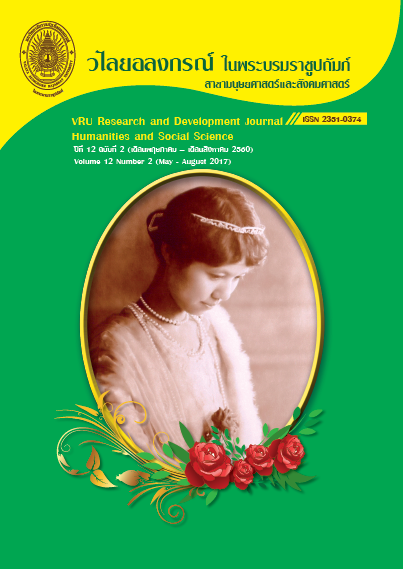จุดพลิกจากวิกฤตสู่ความเติบโตที่ยั่งยืน: โอกาสทางการพัฒนาของธุรกิจผู้รับจ้างผลิตเสื้อผ้าตามแบบและตราสินค้าของลูกค้าในประเทศไทย
Main Article Content
Abstract
เป้าหมายการวิจัย คือ การวิเคราะห์ธุรกิจเสื้อผ้าของไทยโดยใช้แนวคิดเกี่ยวกับความสามารถทางการแข่งขันของไมเคิล อี พอร์เตอร์ และเสนอวิธีการที่เหมาะสมในทางปฎิบัติเพื่อการสร้างความสามารถทางการแข่งขันของผู้รับจ้างผลิตตามแบบและตราสินค้าของลูกค้า โดยข้อมูลเชิงลึกจากการเลือกกลุ่มตัวอย่างสัมภาษณ์แบบเจาะจงในช่วงปี 2014-2016 และข้อมูลที่เกี่ยวข้องจะถูกวิเคราะห์ในเชิงพรรณนา การศึกษาพบว่ามีจุดอ่อนหลายประเด็นในด้านต่างๆของแบบจำลองเพชรโดยเฉพาะการเพิ่มขึ้นของค่าแรงโดยเปรียบเทียบ การขาดแคลนแรงงาน การขาดแคลนปัจจัยพิเศษจำเพาะอุตสาหกรรม อุปสงค์ที่ขาดมิติความซับซ้อน ความเชื่อมโยงในห่วงโซ่อุปทานที่ไม่เข้มแข็ง และการเน้นใช้กลยุทธ์การตัดราคาในการแข่งขัน ในขณะที่จุดแข็งมีจำนวนไม่มากนัก ได้แก่ ทักษะฝีมือแรงงานที่ดี และบริษัทที่บริหารงานเชิงรุกบางแห่งมีทักษะการประกอบการและเครือข่ายธุรกิจในแนวตั้งที่เข้มแข็ง ทั้งนี้เพื่อความอยู่รอด ผู้รับจ้างผลิตเสื้อผ้าของไทยควรมุ่งเน้นที่การยกระดับทักษะแรงงานและความคล่องตัว ควรพัฒนาระบบการจัดการข้อมูล การรักษาความลับ นวัตกรรมพื้นฐาน การวางแผนร่วมและสร้างความร่วมมือเชิงลึกกับลูกค้าหลัก การวิจัยพฤติกรรมของลูกค้าหลัก และความเชี่ยวชาญเฉพาะที่เหมาะสม
The research purposes were analyzing Thai clothing business under the concept of Michael E. Porter competitiveness and providing realistic methods to nourish Original Equipment Manufacturer (OEM) competitiveness. The In-depth data from purposively sampling interviewees in 2014-2016 and related data were descriptively analyzed. There were many weak points in each diamond model facet especially higher relative wage, labor shortage, scarcity of specialized factors, unsophisticated demand, feeble supply chain linkages, and orientation of competitive strategy towards price cutting. A few strong points were nice labor handiwork skill as well as solid entrepreneurial skill and private vertical business network of some progressive firms. To survive, Thai clothing OEM should center on raising labor skill and agility. Data management system, secrecy concealment, and basic innovation should be promoted. Co-planning and in-depth collaboration with main customers, as well as research on their behavior should be fostered. Appropriate type of specialization should also be developed.
Article Details
ลิขสิทธิ์บทความวิจัยที่ได้รับการตีพิมพ์เผยแพร่ในวารสารมนุษยศาสตร์และสังคมศาสตร์ วไลยอลงกรณ์ ในพระบรมราชูปถัมภ์ ถือเป็นกรรมสิทธิ์ของคณะมนุษยศาสตร์และสังคมศาสตร์ มหาวิทยาลัยราชภัฏวไลยอลงกรณ์ ในพระบรมราชูปถัมภ์ ห้ามนำข้อความทั้งหมดหรือบางส่วนไปพิมพ์ซ้ำ เว้นแต่จะได้รับอนุญาตจากมหาวิทยาลัยเป็นลายลักษณ์อักษร
ความรับผิดชอบ เนื้อหาต้นฉบับที่ปรากฏในวารสารมนุษยศาสตร์และสังคมศาสตร์ วไลยอลงกรณ์ ในพระบรมราชูปถัมภ์ เป็นความรับผิดชอบของผู้นิพนธ์บทความหรือผู้เขียนเอง ทั้งนี้ไม่รวมความผิดพลาดอันเกิดจากเทคนิคการพิมพ์
References
Kohpaiboon, A. (2009). MNEs and the global integration of the Thai clothing industry: policy implications for SME development. Thammasat Economic Journal 27 (2): 35-76.
__________ and P. Kulthanavit. (2011). Adjustment of Thai Clothing Industry in the Post-ATC Era. Report to Thai Health Promotion Foundation in May, 2011.
Porter, M. E. (1990). The Competitive Advantage of Nations. New York: The Free Press.
Prachachat Online. (2016, August 28). Garment and footwear factories in Cambodia had gradually closed down amounting to 70 units. Retrieved October 2, 2016, from Prachachat Website: http://m.prachachat.net/news_ detail.php?newsid=1472361490
Sasin. (2003a). A Study Project on Competitiveness Development of Thailand (Vol. 1: A Study in Macro Level). Report to NESDB in August, 2003.
__________. (2003b). A Study Project on Competitiveness Development of Thailand (Vol. 2: Case Studies in Industrial Level). Report to NESDB in August, 2003.
Thailand Textile Institute. (2002). Bangkok: A World Fashion City. n.p.
__________. (2005). Development and Linkage between Entrepreneurs of Textile and Garment’s Cluster for Investment Development. n.p.
Verbeke, A. (2009). International Business Strategy. UK: Cambridge University Press.
Wongsamuth, N. (2014, February 5). Bangkok Fashion City to hit runway again: Project budget slashed in light of past failures. Retrieved October 4, 2016, from Bangkok Post Website: http://www.bangkokpost.com/print/393252/


